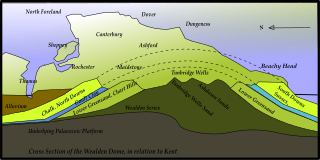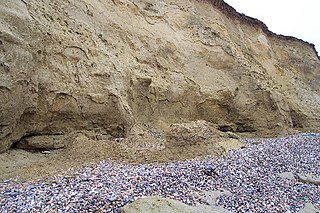
The geology of London comprises various differing layers of sedimentary rock upon which London, England is built.

The geology of London comprises various differing layers of sedimentary rock upon which London, England is built.
The oldest rocks proved through boreholes to exist below London are the old, hard rocks of the Palaeozoic. These consist of Silurian mudstones and sandstones, [1] generally overlain by Devonian strata which are largely of Old Red Sandstone. The Devonian rocks are absent in parts of South London. [2] The Palaeozoic rocks dip southwards and are more than 1,000 metres below the English Channel. Above this is a 60-metre thick layer of impermeable Gault clays. These clays are relatively young, only going back to the early Cretaceous which began around 144 million years ago.
On top of these clays is a non-contiguous layer of Upper Greensand above which lies a rolling bed of white chalk about 200 metres thick. In the Lower Chalk and in the lower region of the Middle Chalk there are abundant fossilized shell fragments, especially Inoceramus clams. In places these form the greater part of the rock but they decrease in amount upwards in the succession. Flints are abundant in the Upper Chalk.
These bands of chalk form the basis of the London Basin, a syncline the outcrop of which is v-shaped opening to the east and bounded by chalk outcrops forming hills: the North Downs to the south of London, and the Chilterns to the north. The chalk is a soft white limestone that is different in appearance to other limestones because it is porous and earthy whilst others are compact and crystalline.

The chalk basin has been infilled with a sequence of clays and sands of the more recent Paleogene Period, then Neogene Period (1.6 to 66.4 million years old). Most significant is the stiff, grey-blue London Clay, a marine deposit which is well known for the fossils it contains and can be over 150 metres thick beneath the city. This supports most of the deep foundations and tunnels that exist under London.
Also in this area are the Lambeth Group (formerly known as the Woolwich and Reading Beds, though those beds have been recently deprecated in 1994 in favour of the Lambeth Group by the British Geological Survey to conform with new standards and to allow scope for more detailed subdivisions) and Thanet Sands. Most of these sand and clays were deposited 60-50 million years ago during the Eocene. Southern England at this time was covered by a warm tropical sea: this is shown by the fossil evidence. The sands contain animals that lived in both estuaries and freshwater. Some species burrowed into the underlying chalk. [3]
Above this is the subsoil which consists of deposits of gravel up to 10 metres deep. This was deposited during the last ice-age ½ million years ago when the River Thames was diverted to its present position. While establishing its new path, the river eroded its valley, creating a series of sand and gravel terraces. These terraces are named after the area they are best known in, for example: Dartford Heath Gravel, Swanscombe, Orsett Heath, Corbets Tey, Mucking, West Thurrock, Kempton Park, Shepperton, Staines and Tilbury Gravels. [4]
The sand and gravel terraces are made up of pebbles with flint, quartz and quartzite. In places, there are deposits of brickearth, which is a mixture of clay and sand that has supported London's long-standing brick-making industry. On top of these natural layers are the deposits of hundreds of years of human occupation. In the oldest parts the City of London and the City of Westminster this layer can be up to 6 metres deep. [5]

The geology of Great Britain is renowned for its diversity. As a result of its eventful geological history, Great Britain shows a rich variety of landscapes across the constituent countries of England, Wales and Scotland. Rocks of almost all geological ages are represented at outcrop, from the Archaean onwards.

The geology of Hertfordshire describes the rocks of the English county of Hertfordshire which are a northern part of the great shallow syncline known as the London Basin. The beds dip in a south-easterly direction towards the syncline's lowest point roughly under the River Thames. The most important formations are the Cretaceous chalks, which are exposed as the high ground in the north and west of the county, and the Cenozoic rocks made up of the Paleocene age Reading beds and Eocene age London Clay that occupies the remaining southern part.

Dorset is a county in South West England on the English Channel coast. Covering an area of 2,653 square kilometres (1,024 sq mi); it borders Devon to the west, Somerset to the north-west, Wiltshire to the north-east, and Hampshire to the east. The great variation in its landscape owes much to the underlying geology, which includes an almost unbroken sequence of rocks from 200 to 40 million years ago (Mya) and superficial deposits from 2 Mya to the present. In general, the oldest rocks appear in the far west of the county, with the most recent (Eocene) in the far east. Jurassic rocks also underlie the Blackmore Vale and comprise much of the coastal cliff in the west and south of the county; although younger Cretaceous rocks crown some of the highpoints in the west, they are mainly to be found in the centre and east of the county.

The Lambeth Group is a stratigraphic group, a set of geological rock strata in the London and Hampshire Basins of southern England. It comprises a complex of vertically and laterally varying gravels, sands, silts and clays deposited between 56-55 million years before present during the Ypresian age. It is found throughout the London Basin with a thickness between 10m and 30m and the Hampshire Basin with a thickness between 50m and less than 25m. Although this sequence only crops out in these basins, the fact that it underlies 25% of London at a depth of less than 30m means the formation is of engineering interest for tunnelling and foundations.

The geology of England is mainly sedimentary. The youngest rocks are in the south east around London, progressing in age in a north westerly direction. The Tees-Exe line marks the division between younger, softer and low-lying rocks in the south east and the generally older and harder rocks of the north and west which give rise to higher relief in those regions. The geology of England is recognisable in the landscape of its counties, the building materials of its towns and its regional extractive industries.

Kent is the south-easternmost county in England. It is bounded on the north by the River Thames and the North Sea, and on the south by the Straits of Dover and the English Channel. The continent of Europe is 21 miles across the straits.

The London Basin is an elongated, roughly triangular sedimentary basin approximately 250 kilometres (160 mi) long which underlies London and a large area of south east England, south eastern East Anglia and the adjacent North Sea. The basin formed as a result of compressional tectonics related to the Alpine orogeny during the Palaeogene period and was mainly active between 40 and 60 million years ago.

The Geology of Yorkshire in northern England shows a very close relationship between the major topographical areas and the geological period in which their rocks were formed. The rocks of the Pennine chain of hills in the west are of Carboniferous origin whilst those of the central vale are Permo-Triassic. The North York Moors in the north-east of the county are Jurassic in age while the Yorkshire Wolds to the south east are Cretaceous chalk uplands. The plain of Holderness and the Humberhead levels both owe their present form to the Quaternary ice ages. The strata become gradually younger from west to east.

The Hampshire Basin is a geological basin of Palaeogene age in southern England, underlying parts of Hampshire, the Isle of Wight, Dorset, and Sussex. Like the London Basin to the northeast, it is filled with sands and clays of Paleocene and younger ages and it is surrounded by a broken rim of chalk hills of Cretaceous age.

The geology of East Sussex is defined by the Weald–Artois anticline, a 60 kilometres (37 mi) wide and 100 kilometres (62 mi) long fold within which caused the arching up of the chalk into a broad dome within the middle Miocene, which has subsequently been eroded to reveal a lower Cretaceous to Upper Jurassic stratigraphy. East Sussex is best known geologically for the identification of the first dinosaur by Gideon Mantell, near Cuckfield, to the famous hoax of the Piltdown man near Uckfield.
The geology of Essex in southeast England largely consists of Cenozoic marine sediments from the Palaeogene and Neogene periods overlain by a suite of superficial deposits of Quaternary age.
The geology of Kent in southeast England largely consists of a succession of northward dipping late Mesozoic and Cenozoic sedimentary rocks overlain by a suite of unconsolidated deposits of more recent origin.
The geology of Norfolk in eastern England largely consists of late Mesozoic and Cenozoic sedimentary rocks of marine origin covered by an extensive spread of unconsolidated recent deposits.

The Thanet Formation is a geological formation found in the London Basin of southeastern England. It is of early to mid-Thanetian age and gave its name to that stratigraphic interval. It was previously known as the Thanet Beds, the Thanet Sands and the Thanet Sand Formation. It was named after the Isle of Thanet. The type sections are Herne Bay in Kent for the upper part of the formation and Pegwell Bay for the lower part. It lies unconformably on the Late Cretaceous Chalk Group. It unconformably underlies the Lambeth Group, generally the Upnor Formation but in Essex it is the Reading Formation.
The geology of West Sussex in southeast England comprises a succession of sedimentary rocks of Cretaceous age overlain in the south by sediments of Palaeogene age. The sequence of strata from both periods consists of a variety of sandstones, mudstones, siltstones and limestones. These sediments were deposited within the Hampshire and Weald basins. Erosion subsequent to large scale but gentle folding associated with the Alpine Orogeny has resulted in the present outcrop pattern across the county, dominated by the north facing chalk scarp of the South Downs. The bedrock is overlain by a suite of Quaternary deposits of varied origin. Parts of both the bedrock and these superficial deposits have been worked for a variety of minerals for use in construction, industry and agriculture.

The geology of Surrey is dominated by sedimentary strata from the Cretaceous, overlaid by clay and superficial deposits from the Cenozoic.
This article describes the geology of the Broads, an area of East Anglia in eastern England characterised by rivers, marshes and shallow lakes (‘broads’). The Broads is designated as a protected landscape with ‘status equivalent to a national park’.
This article describes the geology of the New Forest, a national park in Hampshire, in Southern England.
The geology of Lithuania consists of ancient Proterozoic basement rock overlain by thick sequences of Paleozoic, Mesozoic and Cenozoic marine sedimentary rocks, with some oil reserves, abundant limestone, dolomite, phosphorite and glauconite. Lithuania is a country in the Baltic region of northern-eastern Europe.
The geology of Denmark includes 12 kilometers of unmetamorphosed sediments lie atop the Precambrian Fennoscandian Shield, the Norwegian-Scottish Caledonides and buried North German-Polish Caledonides. The stable Fennoscandian Shield formed from 1.45 billion years ago to 850 million years ago in the Proterozoic. The Fennoscandian Border Zone is a large fault, bounding the deep basement rock of the Danish Basin—a trough between the Border Zone and the Ringkobing-Fyn High. The Sorgenfrei-Tornquist Zone is a fault-bounded area displaying Cretaceous-Cenozoic inversion.